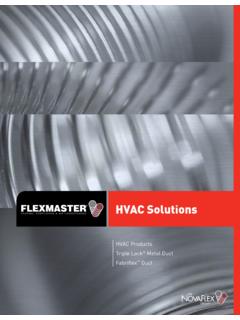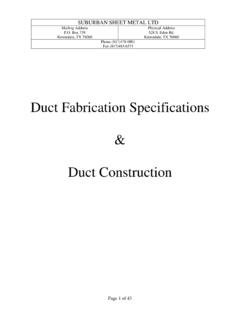Transcription of Airflow Is Critical To HVAC System Performance
1 Airflow Is Critical To hvac System Performance By, Chris Van Rite, M&M Manufacturing Co. Q. Does Air Flow really make a difference in hvac System Performance ? A. Absolutely! Equipment SEER is based on the manufacturer s efficiency rating with no resistance factored in for the duct System . A bad duct System causes the equipment to work harder and less efficiently. Q. If a duct installation passes inspection, is it a good duct System ? A. Not necessarily. Most building codes fail to address air flow. A duct System with terrible air flow can pass code inspection in many cities as long as it is properly sealed and insulated. Too many contractors assume that if they install duct as their competitors do and the job passes inspection, it must be a good duct System .
2 It is important to realize that when we depend on code inspections to set the benchmark for good and bad, we are building to the lowest level allowed rather than the highest possible quality. Few people would argue that the quality of all materials and workmanship is better in new homes today than it was 30 years ago. Market pressures force contractors to look for ways of cutting costs often at the expense of quality and Performance . One of the casualties of this trend has been the hvac duct System . Technology and higher federal standards have brought about significant improvements in hvac equipment, but the quality of duct systems and overall System installation has declined.
3 Founded in 1991, the Consortium for Energy Efficiency (CEE) is a non-profit, public benefit corporation that actively promotes the use of energy-efficient products and services. CEE reports that according to recent research, most residential central air conditioning systems are not installed properly . This not only increases energy use but also reduces comfort and contributes to peak demand for electricity. Here is a breakdown of major problem areas and the frequency with which they occur: Over sizing of equipment - 47 % Inadequate Airflow - 70 % Improper refrigerant charge - 44 % Correcting these problems could reduce air conditioning peak demand by 14 percent in existing homes and 25 percent in new construction .
4 Proper installation and maintenance could also reduce air conditioning energy bills by an average of 24 percent in existing homes and 35 percent in new construction . Consortium for Energy Efficiency (CEE) The True Cost of Flex Trade-offs Between Material Cost and Performance Flex is cheap and easy, but because of its spiral wire helix construction , flex duct has the highest friction loss when compared to Sheet Metal duct or Fiberglass duct Board. The inner core of flex changes shape with compression and bending, which increases turbulence and friction loss. Unfortunately compression and bending are the very attributes that make flex duct so popular.
5 A good example of how easily flex is compressed can be found in the factory packaging. Twenty-five feet of 8 R-6 flex can be packed into a shipping bag that is only about 22 inches long. It s no surprise that installers prefer flex. Because it is soft and flexible, installers find it easy to squeeze flex through tight places, kink it around corners and compress excessive lengths between fitting connections. The result is a duct System that reduces equipment efficiency and costs the homeowner hundreds of dollars more per year and thousands of dollars over the life of the System in higher utility bills. Lower cost and ease of installation have made flex quite popular particularly in Southern and Western states.
6 Contractors and builders have discovered that a flex duct System can be installed just about anywhere with little or no accommodation in the framing or the design of the home. Some states restrict the use of flex to 5 feet or less at the end of a sheet metal duct run. This forces contractors and builders to work together to accommodate a proper duct System . But in states where flex is allowed to be installed without restrictions, a disturbing trend has developed toward bad installations and an apparent disregard for Airflow . The Air Diffusion Council (ADC) is an association of manufactures of flexible air duct . ADC publishes an installation guide titled Flexible duct Performance & Installation Standards.
7 The following excerpts warn the installers of the dangers of installing flex inappropriately. The number of bends, the number or degrees in each bend and the amount of sag allowed between support joists will have serious effects on System Performance due to the increased resistance each introduces . Install duct fully extended, do not install in the compressed state or use excess lengths. This will noticeably increase friction losses . The Air Diffusion Council - Flexible duct Performance & Installation Standards Higher Friction Loss = Less CFM (volume) When less air is delivered, the System has to run longer to achieve the desired comfort level.
8 Airflow problems have plagued the hvac industry for years. Unfortunately some contractor s remedy for poor Airflow has been to oversized equipment rather than to address the root problem. Design tools such as the friction loss tables in ACCA Manual D and Ductulators are used to size ducts to deliver the desired amount of air, but these design tools assume certain installation standards some of which date back to the 1950s. As the quality of modern duct installations has declined, the design tools don t always correlate with installed duct Performance . In 2002 a comprehensive review of Airflow in hvac duct was commissioned by the Air Distribution Institute in cooperation with ASHRAE and other co-funding partners.
9 The Energy Systems Laboratory (ESL) at Texas A&M University undertook this research in order to verify the accuracy of the Manual D friction loss tables and to assess whether the test methods used to gather friction loss data appropriately relate to modern installation practices. The ESL research concluded that when following test protocols prescribed by ASHRAE, the Manual D friction loss tables and therefore the ductulators that correlate with Manual D are accurate for both round metal duct and flex. However when flex was tested under As Built conditions such as we see in modern installations, friction losses increased as much as 10 times higher than predicted by Manual D.
10 A similar study conducted by Lawrence Berkeley National Laboratory found very similar results. The prescribed method for testing air flow in flexible duct requires that it be stretched tight and released on a flat surface. This results in the flex resting at approximately 4% straight line compression. Air is then forced through the test duct section and sensors record pressure loss. The problem is that flex is rarely installed in a straight line and stretched as in the prescribed test method. One common mistake made by installers is not cutting off excess lengths of flex duct before making connections. This practice compresses the installed flex into a shorter length much like an accordion.







